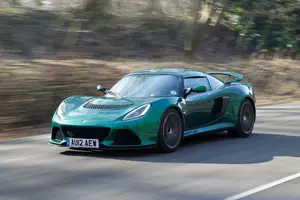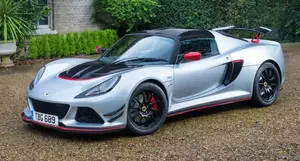
| Vehicle | Precise engine size | Difference from world average | Engine size to consumption ratio | Horsepower from 1 L | Engine size to 100 kg of weight |
|---|---|---|---|---|---|
| Cup 430 3.5 V6 |
3.46 L (3456 cc) |
47.3% bigger | - | 126 hp from 1 L | 314 cc to 100 kg |
| Sport 410 3.5 V6 |
3.46 L (3456 cc) |
47.3% bigger | 157 cc to 1 mpg | 120 hp from 1 L | 314 cc to 100 kg |
| Sport 350 V6 |
3.46 L (3456 cc) |
47.3% bigger | - | 101 hp from 1 L | 314 cc to 100 kg |
| Vehicle | Cup 430 3.5 V6 |
|---|---|
| Precise engine size | 3.46 L (3456 cc) |
| Difference from world average | 47.3 bigger |
| Engine size to consumption ratio | - |
| Horsepower from 1 L | 126 hp from 1 L |
| Engine size to 100 kg of weight | 314 cc to 100 kg |
| Vehicle | Sport 410 3.5 V6 |
| Precise engine size | 3.46 L (3456 cc) |
| Difference from world average | 47.3 bigger |
| Engine size to consumption ratio | 157 cc to 1 mpg |
| Horsepower from 1 L | 120 hp from 1 L |
| Engine size to 100 kg of weight | 314 cc to 100 kg |
| Vehicle | Sport 350 V6 |
| Precise engine size | 3.46 L (3456 cc) |
| Difference from world average | 47.3 bigger |
| Engine size to consumption ratio | - |
| Horsepower from 1 L | 101 hp from 1 L |
| Engine size to 100 kg of weight | 314 cc to 100 kg |

| Vehicle | Precise engine size | Difference from world average | Engine size to consumption ratio | Horsepower from 1 L | Engine size to 100 kg of weight |
|---|---|---|---|---|---|
| Sport 410 3.5 V6 |
3.46 L (3456 cc) |
47.3% bigger | 157 cc to 1 mpg | 120 hp from 1 L | 314 cc to 100 kg |
| Vehicle | Sport 410 3.5 V6 |
|---|---|
| Precise engine size | 3.46 L (3456 cc) |
| Difference from world average | 47.3 bigger |
| Engine size to consumption ratio | 157 cc to 1 mpg |
| Horsepower from 1 L | 120 hp from 1 L |
| Engine size to 100 kg of weight | 314 cc to 100 kg |

| Vehicle | Precise engine size | Difference from world average | Engine size to consumption ratio | Horsepower from 1 L | Engine size to 100 kg of weight |
|---|---|---|---|---|---|
| Cup 380 3.5 V6 |
3.46 L (3456 cc) |
47.3% bigger | 150 cc to 1 mpg | 110 hp from 1 L | 314 cc to 100 kg |
| Sport 380 3.5 V6 |
3.46 L (3456 cc) |
47.3% bigger | 128 cc to 1 mpg | 110 hp from 1 L | 314 cc to 100 kg |
| Vehicle | Cup 380 3.5 V6 |
|---|---|
| Precise engine size | 3.46 L (3456 cc) |
| Difference from world average | 47.3 bigger |
| Engine size to consumption ratio | 150 cc to 1 mpg |
| Horsepower from 1 L | 110 hp from 1 L |
| Engine size to 100 kg of weight | 314 cc to 100 kg |
| Vehicle | Sport 380 3.5 V6 |
| Precise engine size | 3.46 L (3456 cc) |
| Difference from world average | 47.3 bigger |
| Engine size to consumption ratio | 128 cc to 1 mpg |
| Horsepower from 1 L | 110 hp from 1 L |
| Engine size to 100 kg of weight | 314 cc to 100 kg |

| Vehicle | Precise engine size | Difference from world average | Engine size to consumption ratio | Horsepower from 1 L | Engine size to 100 kg of weight |
|---|---|---|---|---|---|
| 1.8 i 16V |
1.8 L (1796 cc) |
23.4% smaller | - | 107 hp from 1 L | 200 cc to 100 kg |
| 1.8 i 16V Sport 240R |
1.8 L (1796 cc) |
23.4% smaller | - | 137 hp from 1 L | 200 cc to 100 kg |
| Vehicle | 1.8 i 16V |
|---|---|
| Precise engine size | 1.8 L (1796 cc) |
| Difference from world average | 23.4 smaller |
| Engine size to consumption ratio | - |
| Horsepower from 1 L | 107 hp from 1 L |
| Engine size to 100 kg of weight | 200 cc to 100 kg |
| Vehicle | 1.8 i 16V Sport 240R |
| Precise engine size | 1.8 L (1796 cc) |
| Difference from world average | 23.4 smaller |
| Engine size to consumption ratio | - |
| Horsepower from 1 L | 137 hp from 1 L |
| Engine size to 100 kg of weight | 200 cc to 100 kg |

| Vehicle | Precise engine size | Difference from world average | Engine size to consumption ratio | Horsepower from 1 L | Engine size to 100 kg of weight |
|---|---|---|---|---|---|
| 1.8 i 16V |
1.8 L (1795 cc) |
23.5% smaller | - | 99 hp from 1 L | 224 cc to 100 kg |
| Vehicle | 1.8 i 16V |
|---|---|
| Precise engine size | 1.8 L (1795 cc) |
| Difference from world average | 23.5 smaller |
| Engine size to consumption ratio | - |
| Horsepower from 1 L | 99 hp from 1 L |
| Engine size to 100 kg of weight | 224 cc to 100 kg |